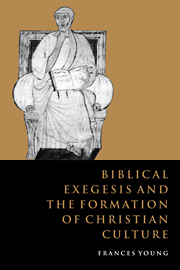Book contents
- Frontmatter
- Contents
- Preface
- List of abbreviations
- Introduction
- PART I EXEGESIS AND THE UNITY OF THE SCRIPTURES
- PART II THE BIBLE AS CLASSIC
- PART III LANGUAGE AND REFERENCE
- PART IV THE BIBLE AND THE LIFE OF FAITH
- Conclusion and retrospect: towards an outline historical account
- Bibliography
- 1 Index ofbiblicaI references
- 2 Index of modern scholars
- 3 Index of subjects
Conclusion and retrospect: towards an outline historical account
Published online by Cambridge University Press: 02 December 2009
- Frontmatter
- Contents
- Preface
- List of abbreviations
- Introduction
- PART I EXEGESIS AND THE UNITY OF THE SCRIPTURES
- PART II THE BIBLE AS CLASSIC
- PART III LANGUAGE AND REFERENCE
- PART IV THE BIBLE AND THE LIFE OF FAITH
- Conclusion and retrospect: towards an outline historical account
- Bibliography
- 1 Index ofbiblicaI references
- 2 Index of modern scholars
- 3 Index of subjects
Summary
Can a revised history of exegesis now be sketched? Origen, who really did build an alternative paideia based on the alternative biblical literature, pirating all the methods used in the Hellenistic schools for the exegesis of barbarian books and defending that position against the criticisms of Celsus, will clearly provide an important pivot, but the attempt here is to offer a chronological account.
In such a history, the New Testament's use of the Jewish scriptures cannot be passed over, for here the initial lines were laid down. The letters of Paul, our earliest Christian writer, are steeped in scriptural language and allusion. Paul was a Jew who knew his Bible at the deep, almost unconscious, level in which its language and perspective, especially but not solely that of Psalms and Prophets, created his world. His writing is in part collage, his argument is given authority by quotation. Along with some other New Testament writers who are on occasion contrasted with him – the authors of Hebrews and of Matthew's Gospel, and even those who produced the Johannine material – Paul evidences an exegesis of scripture which is unselfconscious, entirely taken for granted. There is, of course, a different perspective from most Jews, yet here we seem still to be reading the work of Jews with a new perspective on their own heritage. Their prophecies, they believe, have been fulfilled, and that gives a new focus, namely Jesus the Christ; their covenant has been renewed, and that gives a different approach to the true import of their law. But the crucial transformation, I suggest, does not lie here.
- Type
- Chapter
- Information
- Biblical Exegesis and the Formation of Christian Culture , pp. 285 - 299Publisher: Cambridge University PressPrint publication year: 1997



